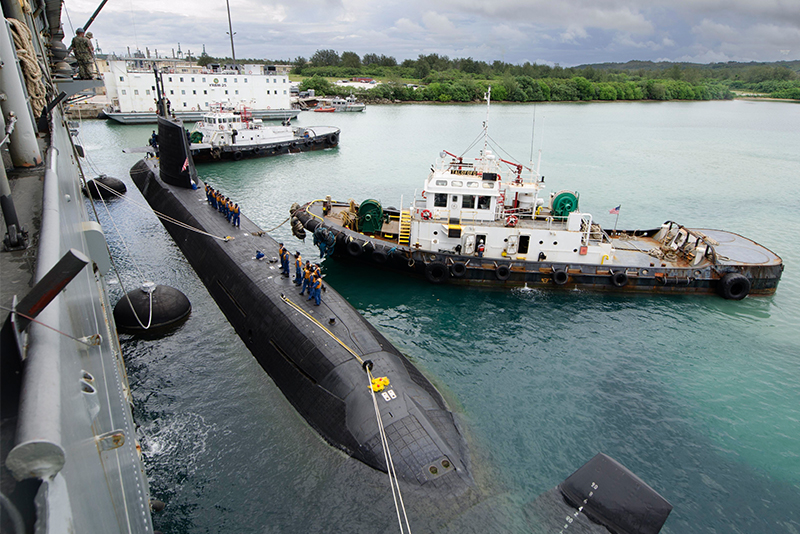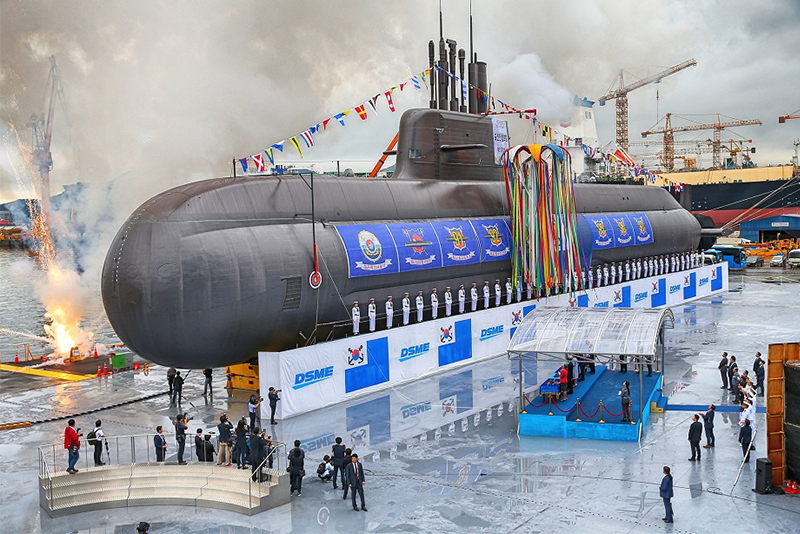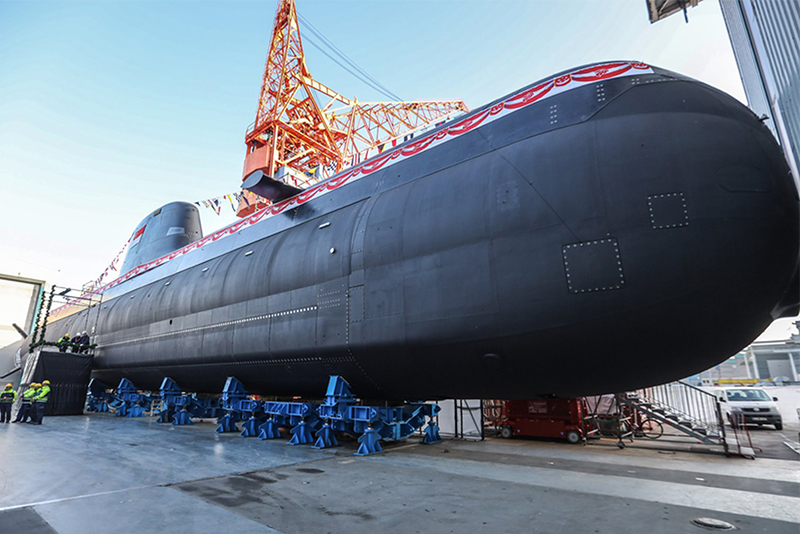
The number of navies that can now invest in submarine technology is increasing, although operational capability will still vary widely.
The submarine arms race in the Indo-Pacific region that has been underway for almost 10 years is continuing apace as more navies are expanding their fleets and are bringing new boats into service
A combination of relatively strong economic growth in the region and the gradual realisation by political leaders that the maritime domain is of importance to their country’s finances and security mean that naval capabilities have received some attention. There is also a heightened appreciation of maritime security issues in the different sub-regions of the Indo-Pacific and the desire to possess submarines as reputed weapons for sea control.
Dr Collin Koh Swee Lean, from the Institute of Defence and Strategic Studies at the S. Rajaratnam School of International Studies in Singapore told AMR that while the increase in the size and sophistication of China’s People’s Liberation Army Navy (PLAN) “does play a significant role spurring the equivalent build-ups by at least some regional countries, such as Japan, there are a few other drivers.”
This includes the ‘me too’ need to copy what other countries are doing, growth in regional uncertainties that require improvement in defence, and a modernisation trend towards a more capable and balanced fleet. In terms of status, “for some countries, acquiring a submarine equates to being in the ‘club’ – one that brings prestige because operating and maintaining a submarine capability becomes testament to the country’s financial and technical prowess,” Collin said.
China wants the status of developing capabilities on a par with the US Navy (USN) and the PLAN is moving on to building the next generation of nuclear-powered ballistic missile (SSBN), nuclear-powered attack (SSN) and conventional diesel-electric powered (SSK) submarines.
The PLAN is developing a new Type 096 SSBN boat called the Tang-class. It is expected to be larger and more capable than the current Type 094 Jin-class that have provided the PLAN with its first continuous-at-sea-deterrent nuclear posture with at least four boats in-service offering a round-the-clock nuclear launch capacity.
The PLAN’s six Type 093 Shang-class SSNs are set to be joined by a new class of five Type 095 Sui-class SSNs. Media reports state that the first of-of-class will enter service in 2020 although it is not clear what stage of production these have reached.
“The Type 095 is supposed to be more capable than the Type 093 SSN with a stronger standoff offensive strike capability – speculated by some to incorporate a robust VLS [vertical launch system] capability to house SLCMs [submarine-launched cruise missiles],” Collins said. “In terms of overall strike capabilities the Type-095 could possibly get close to the US Navy, but less so perhaps in the area of sonar, combat management systems and most importantly, quieting,” he added making it comparable to the later variants of the USN’s Los Angeles-class.
The SSK fleet has been receiving new Type 039A/041 Yuan-class boats, which are a step up in noise reduction over the earlier Type 039 Song-class and Type 035 Ming-class before that. The Yuans have air-independent propulsion but how advanced they are is unclear. Collin said that using insights from imported Kilo-class SSKs from Russia and access to dual-use technology it means that each SSK model has got progressively more capable.
“The Yuan class has evolved into newer variants, most current being the Type-039B/C, which bears an appearance closer to contemporary Western and Japanese designs, especially the Japanese Oyashio for instance. It’s plausible to surmise that these new SSK models have enjoyed improved quieting, hydrodynamic performances, and combat capabilities,” Collin said.
Japan Counters PLAN
Meanwhile Japan’s Maritime Self-Defense Force (JMSDF) is trying to counter PLAN submarine expansion by increasing its fleet of SSKs from 16-18 up to 22. It is achieving this by keeping more of its older Oyashio-class boats in service to supplement the Soryu-class (16SS) that are still entering service. The Soryu-class is built by Mitsubishi Heavy Industry and Kawasaki Heavy Industry shipyards. Production started in 2005 and boat 10, Shoryu (SS 510) was the most recent to be commissioned in March 2019. Up to 14 are expected and the remaining boats (SS 511-514) will be equipped with Li-ion batteries instead of lead acid ones. Whilst the JMSDF can’t match the PLAN for numbers it hopes to retain a qualitative edge over its rival in terms of quieting, acoustic sensor capability and reliability.

Neighbouring South Korea has been gradually developing its own submarine production capacity across three variants of its KSS submarine programme. The first KSS-I Chang Bogo-class SSKs used the Type 209/1400 design from German shipbuilder ThyssenKrupp Marine Systems (TKMS), the second KSS-II Son Won-Il-class variant was based on the Type 214 design. The final boat of this class will be commissioned this year. But the new KSS-III Jangbogo-class SSKs uses a Korean design from local shipbuilder Daewoo Shipbuilding and Marine Engineering (DSME). The KSS-IIIs will replace the Chang Bogo-class and construction of a first batch of three boats is underway. The first-of-class, Dosan Anh Chang-ho was launched in September 2018 and will be commissioned in 2020-21 with the second due to launch in 2020 and commission in 2022. Work on the third started at Hyundai Heavy Industries in 2017. A second batch of three is expected to start construcution this year that could be larger and with more vertical launch tubes.

RAN SEA 1000
At the opposite end of the region, the Royal Australian Navy (RAN) has committed itself to procuring, manning and maintaining 12 new SSKs under its SEA 1000 Attack-class future submarine programme worth about $36 billion (A$50 billion). In 2016 the Shortfin Barracuda 1A design from French naval shipbuilder Naval Group was selected and a Strategic Partnership Agreement was eventually signed in February 2019.
This will manage the relationship between the Australian Commonwealth and the company for 50 years and cover the design, construction and delivery of the boats out to 2054. There is considerable risk in the programme as the design will be heavily modified from its initial SSN layout to become an SSK and it will use a different propulsion, weapon system and combat management system.
But SEA 1000 will also provide Australia with a new state-of-the-art submarine construction facility in South Australia. A submarine design contract was signed in March 2019 that has initiated next steps of the programme. According to the Naval Group the design contract takes in preparations for Attack class construction at the Osborne North naval shipyard on the outskirts of Adelaide. This includes ongoing support to Commonwealth-owned Australian Naval Infrastructure for the design and build of the dedicated submarine construction yard and the information and communications technologies systems to be employed there.
The only other major submarine builder and operator in the Indo-Pacific is India, which is trying to build its own SSBNs, SSNs and SSKs. The Indian Navy (IN) saw its first SSBN, INS Arihant, built by the Navy Shipbuilding Centre in Visakhapatnam, commissioned in 2016 after a very long procurement programme that started in the 1990s. A second boat, Arighat was launched in 2017 but it is not clear when it will be delivered or commissioned. Two more boats are expected to follow. Visakhapatnam will be used for the future production of a new class of six new Indian-built SSNs.
Meanwhile the IN has a requirement for 24 new SSKs but it is struggling to take delivery of six new boats built at Mazagon Docks Ltd (MDL) to the Scorpene design from Naval Group under the Kalvari-class (Project 75) programme. The Naval Group spokesperson told AMR: “Four Scorpene submarines out of six being built by MDL have been already launched, the first one INS Kalvari has been commissioned and has been in service since 2017. The second one is close to completion of trials and delivery.” Kalvari was due to have been commissioned in 2012. When the second boat is commissioned the rest are supposed to follow on an annual drumbeat out to 2022.
India is already embarking on a follow-on project for six more SSKs dubbed Project 75(I). According to the company it has been in contact with IN to propose best suited and adapted technically advanced submarine suiting their expected operational needs. This submarine will be next generation to the Scorpene class with more advanced features suiting the need of the customer. The company is preparing its response to the Expression Of Interest recently issued by IN.

Recapitalisation
Neighbouring Pakistan is responding to the IN build-up with its own SSK re-capitalisation programme. It has decided to buy the S26 – an export variant of the PLAN’s Type 039B – from China. The Pakistan Navy (PN) needs to replace its ageing pair of Hashmat-class Agosta 70A and three Agosta 90B SSKs and has a requirement for up to eight boats.
“The Chinese boats are most likely going to carry a robust offensive strike capability in the form of SLCMs for land attack. The existing fleet of French builds is ageing and no longer economical to maintain in service, so the Chinese boats are meant to block-replace all these eventually,” Collin said. Meanwhile the PN is upgrading the Agosta 90Bs under a $350 million contract with Turkish shipbuilder STM.
China is also supporting Bangladesh, which purchased two old PLAN Type 35B Ming-class SSKs in 2016. Whilst the submarines are not much of a threat the relationship between the two countries will be of concern to India.
China also has influence in South East Asia where Thailand has also decided to buy S26T SSKs. The Royal Thai Navy has a requirement for three boats, showing they are serious about a submarine capability. Collin said that cost is the driving factor in the selection: “With the basket of cash on hand, Thailand could only get one submarine if they insist on Western or even South Korean, and this may not even come with the full training, armaments and after-sales support package they need. And you end up with a token fleet. But with the S26T, the Thais argue that they could get three boats with the full package, which allows them to have a working fleet.”
The Philippines wants to buy submarines under its Horizon 2 programme but it is expected to have modest requirements and a limited budget. A Request for Information (RfI) has been released and Collin believes that Russia has made an offer but it unlikely any foreign shipyard would be interested. Collin believes the Philippine Navy needs to get experience with its anti-submarine warfare frigates and helicopters first before embarking on submarine acquisition.
Indonesia is set to expand its SSK fleet from the existing pair of Type 209 Cakra-class SSKs to six boats. It has received two new Type 209/1400 SSK from DSME called the Nagapasa-class and Indonesia is planning to build a third locally at PT Pal. A contract for a second batch of three boats has been signed that would see more boats built at PT Pal although the shipyard is likely to be getting significant levels of assistance and advice from DSME.
Malaysia already brought its two French-built Scorpene submarines into service in 2009 and has plans to double the size of its fleet to four boats. However, Collin said the budget is a problem and the increased costs and effort of sustaining the existing fleet are of concern in the short term.
Singapore will get four new Invincible-class (Type 218SG) SSK from TKMS to replace the existing two 1960s vintage Challenger-class boats that are still in-service with the Republic of Singapore Navy (RSN). The Invincible-class will be the first new SSKs that the RSN has purchased as the Challengers and the two Archer-class that entered service in 2011 and 2013 were formerly Royal Swedish Navy submarines. TKMS launched the first-of-class, Invincible in February and it is expected to enter service in 2021 with a second boat, Impeccable, due to follow in 2022. Work on boats three and four (Illustrious and Inimitable) has started with a commissioning date expected in 2024.

Vietnam has recently purchased six Kilo-class (Type 636.1) SSKs from Russia in three batches of two that entered service in 2014, 2015 and 2017. Collins said that this show the Vietnamese Navy was serious about having a workable fleet. Not only does it get a robustly-sized fleet of one of the most capable and quiet boats on the market “but it went to the extent of investing in its supporting infrastructure, including a comprehensive on-shore training facility, and even thought about acquiring a submarine rescue capability,” he said.
Taiwan has instead decided to build eight submarines under its Indigenously Defense Submarine (IDS) programme. Taiwan has built a yard for the construction of the boats but even with substantial US and Japanese help there are significant risks. Collin believes that Taiwan does not have much choice: “I surmise Taiwan might have concluded, rightly, that the project risks of going alone with the programme (with foreign aid) is way lower than the risks of finding no suppliers or unreliable suppliers who are susceptible to Chinese pressure.” Eight boats is a significant increase on the existing two Chien Lung-class SSKs but something that is necessary for Taiwan considering Chinese military expansion.
by Tim Fish












